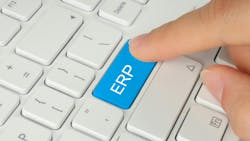Field service reality check: Why integration shouldn't be a deal-breaker
What you’ll learn:
- Integrating specialized field service solutions with your ERP isn't free. But integrating your ERP vendor's own CRM stack isn't seamless, either.
- I've seen large customers negotiate down or eliminate those indirect access charges that ERP vendors use to discourage third-party integrations.
- Too many field service implementations fail because organizations tried to force-fit a solution into their existing technology stack.
I’ve seen the same story play out over the years in enterprise technology again and again: Big ERP upgrades roll through, and suddenly field service and complex asset management are treated like an afterthought—expected to fit somewhere in the system.
But in my experience, these areas are too important and too complex to be forced into a one-size-fits-all solution. Applying flexibility can make a huge difference for operations and, ultimately, the customer experience.
See also: Our annual State of Initiative Survey is open!
Across manufacturing, utilities, and heavy industrial sectors I’m consistently seeing companies committing to massive ERP projects.
These are $50 million-plus, five-year-plus implementations and, somewhere in the planning process, someone says, "We should probably handle field service too. Our ERP vendor can do that, since the ERP Asset Management functionality is the only option, right?"
The assumption is compelling. You're already spending millions on your enterprise system. The licenses are there. The integration should be seamless. Why couldn’t you just add field service to the mix? But here's the reality I've witnessed firsthand time and time again: It never works the way you think it will.
When "free" becomes expensive
I recently worked with a major aerospace manufacturer going through a massive ERP upgrade. The business case for modernization of their MRO operations was solid—they needed to efficiently move jet engine components through their cleaning and polishing facility. The ERP vendor's response? "We'll do it for free. You're buying everything else anyway."
See also: Human intelligence plus AI and how supply chains are changing with this collaboration
The project crashed and burned. They put the entire MRO automation project on hold, not just the ERP field service component, but the whole initiative. Meanwhile, the fit for a purpose-built field service solution was obvious—the scheduling complexity, the station-to-station workflow management, the technician experience. These aren't afterthoughts; they're the core of what makes field service successful.
The integration myth
Let me address the elephant in the room: integration costs. Yes, integrating specialized field service solutions with your ERP isn't free. But here's what most people don't realize—integrating your ERP vendor's own CRM stack isn't seamless, either. The idea that keeping everything within one vendor eliminates integration complexity is simply not true.
I've seen too many field service implementations fail because organizations tried to force-fit a solution into their existing technology stack instead of choosing the right tool for the job.
I've seen large customers negotiate down or eliminate those indirect access charges that ERP vendors use to discourage third-party integrations.
At an aerospace manufacturer, we implemented an extensive ERP-to-field-service integration that worked beautifully—much of it point-to-point integration pulling service contracts, asset locations, and other critical data from the ERP with no problems.
The most common enterprise integrations? Field service platforms to ERP systems. That’s extremely telling. In most cases these integrations are required for asset, location, accruals, billings, and for service contracts.
Know your strengths, pick your battles
Here's my practical advice for organizations facing this decision: Play to each platform's strengths.
If your ERP implementation handles asset management well—the heavy lifting around depreciation, complex BOM, component parts, compliance reporting, rate calculations that utilities need—then you don't need to fight that battle.
Leave those capabilities where they work. But get the technician experience, the scheduling, the dispatching, the customer-facing elements into a platform designed for that purpose.
See also: Data-driven factories can use computer vision, analytics to improve quality and safety
When I look at complex industrial use cases—like managing the generators that power major cities—you need project management capabilities, complex workflow orchestration, and technician tools that actually work in the field.
ERP field service in most cases doesn't excel here, and frankly, there are gaps in every platform for the most complex scenarios. But at least in specialized field service ecosystems, you have options. You have apps, extensions, and integrations that can fill those gaps.
The user experience reality
Let's talk about what happens after you've made the technology decision. Your technicians are in the field. They're using tablets and mobile devices in challenging environments. They need intuitive interfaces, offline capabilities, and workflows that make sense for their daily reality.
The question isn't whether you can make ERP field service work. It's whether you should, when better options exist.
Looking forward: The agent-enabled future
The conversation is evolving beyond traditional field service into areas like predictive maintenance and IoT integration. We're working on use cases that involve AI agents on the front end. In fact, Salesforce research found AI agents could help with an estimated 35% of technicians’ administrative tasks so they can instead focus on more fulfilling aspects of their job.
See also: Talking to your data: Agentic AI’s utility in process manufacturing
These agents could process large volumes of IoT data in cloud platforms, analyzing stress patterns on aircraft frames, and turning all of that into actionable field service workflows.
This is where purpose-built platforms shine. The story around AI-enabled field service, the integration with modern cloud architectures, the ability to handle massive data sets while maintaining an intuitive user experience—this is where you see the real differentiation.
The bottom line
I'm not anti-ERP. I've spent enough time integrating with enterprise platforms to respect what they do well. But I've also seen too many field service implementations fail because organizations tried to force-fit a solution into their existing technology stack instead of choosing the right tool for the job.
Your field service success shouldn't be held hostage by your ERP decisions. Integration is solvable. User experience and operational efficiency are what matter in the long run.
See also: ‘Digital retrofitting’ of plant machines offers course through Industry 4.0 to Industry 5.0
Before you default to the "easy" choice of keeping everything in one vendor's ecosystem, ask yourself: Are you optimizing for procurement simplicity or operational excellence?
Because in field service, the difference between those two approaches shows up every day in your technicians' productivity, your customer satisfaction scores, and ultimately, your bottom line.
The question isn't whether you can make ERP field service work. The question is whether you should, when better options exist.
About the Author

Bill Donlan
Bill Donlan is CEO of Astound Digital and leads the company’s global team of 1,000-plus commerce specialists, setting and executing Astound’s vision and strategy. The Miami-based executive is a thought leader across the Salesforce ecosystem with over 30 years of experience helping brands address their digital transformation needs.
